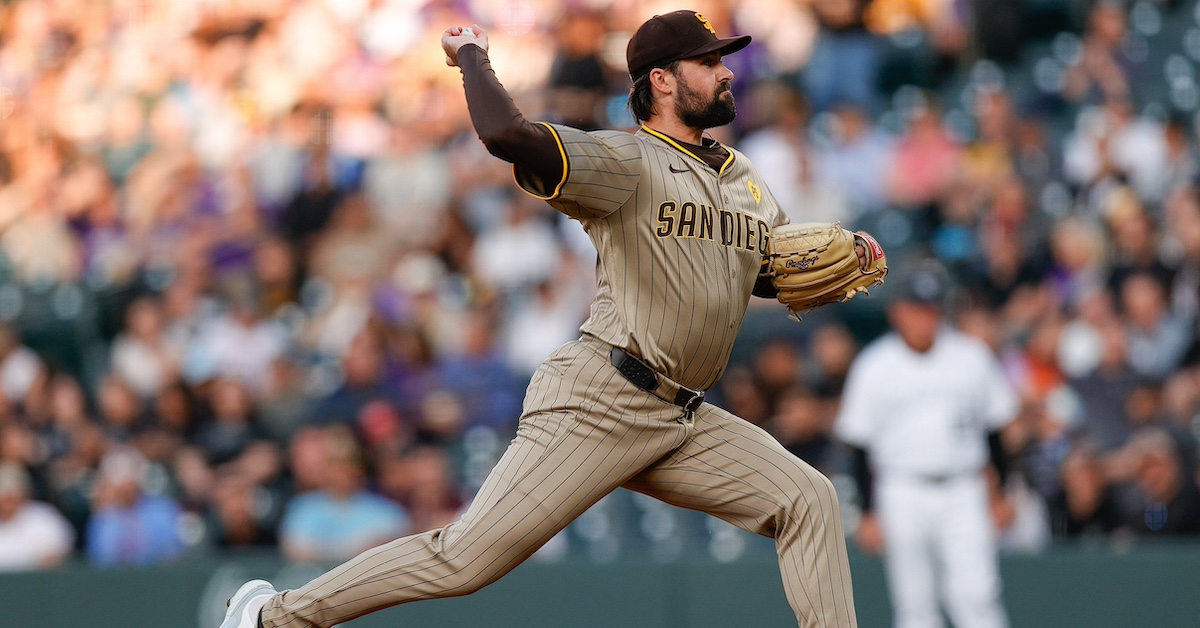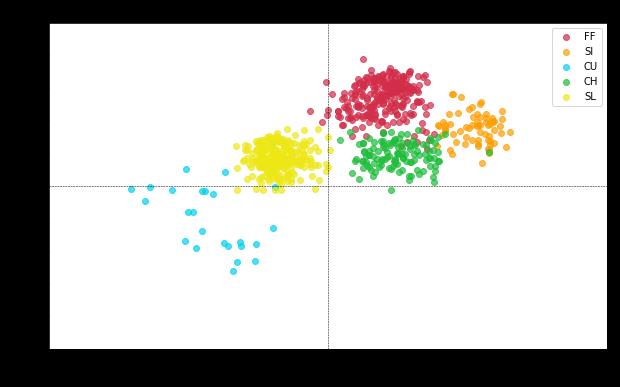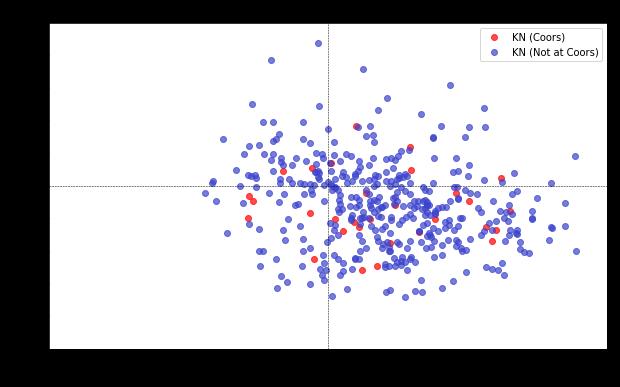
Isaiah J. Downing-USA TODAY Sports
On the first knuckleball thrown at Coors Field in 16 years, Matt Waldron hit home plate umpire Bill Miller right in the nuts.
Nobody — not Waldron, not his catcher Kyle Higashioka, not Miller — appeared to know where the ball was going. Despite Higashioka frequently (and understandably) struggling to track the flight of the ball throughout the rest of the night, Waldron delivered a career-best performance, allowing just one run over six innings.
Perhaps the most surprising part of his performance was the setting. Since 2008, knuckleballers have dodged outings at Coors Field, which sits 5,200 feet above sea level. Conventional wisdom dictates that knuckleballs at altitude are a bad idea, as Cy Young-winning knuckleballer R.A. Dickey told Dave Krieger back in 2012.
“It is tougher to throw at those high altitudes because there’s not much humidity for the ball to kind of resist against,” Dickey said. “At sea level, let’s say in New York, for instance, if I throw a mediocre knuckleball, well, it’s still going to move, it just might not move as sharply or as much. If I throw a mediocre knuckleball in Colorado, it’s going to be a BP fastball right down the middle that I’m going to have to either dodge, or I’m going to just put my glove up for the umpire to throw me another ball because that one just went 450 feet.”
After Waldron’s superb performance, I couldn’t help but question the conventional wisdom. Perhaps, if thrown well, the knuckleball works better at Coors than any other pitch. But is it possible to identify pitchers who can avoid throwing mediocre knuckleballs? And if it is, should the Rockies, notoriously incapable of putting together a quality pitching staff, simply build a rotation full of these knuckleballers?
The most likely answer to both of these questions is “no.” But in the course of my investigation, I discovered something strange: We know way less about the knuckleball than we thought.
…
At Coors Field, every pitch moves less. Part of this is because there is less drag, or air resistance, on the ball; part of it is attributable to the reduction in the Magnus force at altitude. Utah State mechanical and aerospace engineering professor Barton Smith, famous for his work on seam-shifted wake effects, describes the Magnus effect as “the tendency of a spinning ball to move in the direction that the front of the ball is going.” A topspin curveball drops more than it would if only gravity was acting on the ball, while a backspin four-seamer drops less.
Because the Magnus effect is proportional to air density and the air density at altitude is lower, nasty pitches lose a bit of their bite at Coors Field. Therefore, one theory goes that the optimal Rockies pitcher wants to limit the spin-induced movement on their pitches.
Pitching analyst Lance Brozdowski discussed this in a recent post about Ryan Feltner, whose pitches all hover around zero inches of both horizontal and vertical movement. As Lance wrote, “This is the kind of pitcher the Rockies should roll out in every spot of their rotation. Velo, small shapes, average command.”

I had another idea: The Rockies should instead install knuckleballers in every rotation spot. My initial reasoning was that while knuckleballs may have the most total movement of any pitch type, they have the least total spin. The ideal knuckleball makes roughly one rotation during the flight of the ball. Thus, I reasoned, knuckleballs would be the least susceptible to Magnus effects of any given pitch type, and the movement profile would therefore change the least at altitude relative to “spinnier” pitch types.
Sadly, I was wrong. I emailed the baseball physicist Alan Nathan, who explained to me that no matter the pitch type, it will move at 82% of its sea level profile.
“All aerodynamic effects (drag, movement, etc.) are directly proportional to the air density,” Nathan wrote to me. “At otherwise comparable atmospheric conditions, the air density at Coors is about 82% of that at sea level. That means only 82% of the movement on any pitch due to aerodynamic effects, whether it is due to the spin or the seams (the latter is responsible for the knuckleball movement).”
Our limited data bears this out. On the plot below, it appears that the knuckleballs thrown at Coors moved about 80% as much as Waldron’s outlier sea-level knuckleballs:

But I still wasn’t totally satisfied. Even if knuckleballs are affected equally by air resistance factors, they will still have more absolute movement than any other pitch type at altitude — assuming the pitch is thrown with low spin. Waldron himself told reporters after this start that of the five pitches in his arsenal, he felt the knuckleball was the least affected movement-wise.
“I just feel like it stayed the same,” Waldron said.
If thrown well — and here “thrown well” is defined as maintaining a spin rate of roughly 100 rpm, or a single revolution during the ball’s flight — perhaps Waldron’s performance can be the model for the next great Rockies starter. The reduced movement due to altitude effects might even help with commanding the pitch; as Adam Ottavino said on a recent episode of Rates and Barrels, he felt more confident throwing his big bendy sweeper at Coors because the movement profile was more predictable.
“It was a little easier for me at Coors to throw strikes,” Ottavino said.
But how can the Rockies identify knuckleballers who are good at reliably producing low spin rates? This is where things start to get confusing. I tried to test this with Waldron, and the spin rates didn’t make much sense.
…
For over a century, the knuckleball has been described as dancing, fluttering, zigzagging, or wobbling on its way to the plate, making slight detours in its path before landing in the catcher’s glove. This effect was first attributed to the flow of the air interacting with the asymmetrical surface of the baseball in the seminal 1975 Watts and Brown paper “Aerodynamics of a knuckleball.” In 2016, researchers in France identified other aerodynamic effects contributing to the wobble of a slowly spinning ball. (The details are over my head, but the important note is that it isn’t just the seams; other sports balls also experience knuckling effects.)
In 2011, Alan Nathan obtained the raw tracking data from four separate games started by Dickey and Tim Wakefield. Using data that captured the coordinates of the knuckleball at roughly 20 discrete points in space, he calculated that the amount of deviation in the flight path of a knuckleball is small; the maximum wobble, he found, is something like 1.3 centimeters, or about a sixth of the diameter of the ball.
The knuckleball wobbles the most — and is therefore the most unpredictable — when it spins as little as possible. As Aguirre-Lopez et al. wrote in their 2017 paper “A phenomenological model for the aerodynamics of the knuckleball,” “If the ball spins at a frequency low enough (< 50 rpm) to remain as a non-rotating ball, the lift force will be changing over time and a more erratic trajectory will be produced.”
If low frequency spin leads to a “more erratic trajectory,” that would suggest the Rockies want to identify pitchers who can repeatedly throw low-spinning knuckleballs. But there is a major impediment to performing this analysis: The erratic trajectory makes it difficult to reliably capture how much a knuckleball spins.
The first hint that our understanding of knuckleball spin might be askew came from a paper published earlier this year titled “Discrepancies between reported knuckleball spin rates and dynamics” from Aaron Hoskins, a professor of mechanical engineering at Fresno State. Hoskins analyzed “the accuracy of the pitches labeled as knuckleballs” for the first time in the Statcast era and found that the recorded spin rates were “inconsistent with the equations of motion for a knuckleball.” Hoskins had some theories for the discrepancy, but no concrete answers. So I went straight to the source.
I emailed Tom Tango, Major League Baseball’s Senior Data Architect, asking for any help he could provide. He copied Clay Nunnally, a data scientist at MLB, who provided some extremely useful information.
“Hawk-Eye takes a bunch of discrete images of the seams on the ball, then it tries to find a spin solution that best matches the seam set,” Nunnally wrote. “However, in theory, a ball with zero spin looks just like a ball with 3000 rpm spin where the ball rotates back to its original (looking) position in between images. There are ways to break the spin ambiguity, but they don’t always work.”
This “spin ambiguity” is attributable to the number of discrete images that Hawk-Eye uses to match the seam set. The exact number of images is somewhat unclear. In a presentation at the 2020 SABR Analytics Conference, Nunnally said that Hawk-Eye uses “about 20” frames; in a follow-up email, he told me that it is now “more than 30” but declined to specify further.
Regardless of the exact number of frames, the “spin ambiguity” exists. Let’s assume that Hawk-Eye currently trains its algorithm on 40 discrete frames, or an image every 13.5 milliseconds during the flight of the average Matt Waldron knuckleball. In knuckleball time, 13.5 milliseconds might as well be an eternity. If we don’t have a true sense of the full flight of a knuckleball, then how much do we really know about the pitch’s movement properties? Could the pitch even be wobbling more than the Nathan study suggests?
“More data in any problem helps you,” Hoskins, the Fresno State professor, told me. “There’s a chance we’re not capturing all the wobble. We’re definitely having issues with the spin.”
What’s curious is that Hawk-Eye might have some answers. Their most sophisticated cameras are capable of taking images at 300 frames per second, or an image roughly every three milliseconds. With an average Waldron knuckleball moving at 77 mph, that would imply that Hawk-Eye cameras can take close to 150 discrete images of the ball in flight. With nearly five times as many images, we’d surely have more clarity.
When I asked Nunnally why Hawk-Eye uses fewer frames for the spin solution, he told me that “in general, there are some logistical reasons to use less data as opposed to the max amount possible, in some applications.” Left to speculate about those reasons, one could imagine that the explanation is straightforward: The vast majority of pitches maintain a consistent spin axis and therefore do not require hundreds of frames to find a spin solution. Prior to Waldron’s debut last season, there had only been 57 knuckleballs thrown by actual knuckleballers (i.e. not position players) since the beginning of the Hawk-Eye and Statcast partnership. The knuckleball spin rate concern — in so far as it actually is a concern — is a relatively new one.
For now, the knuckleball remains a mystery, something unknowable at the heart of a sport that can otherwise quantify basically everything. Given all that, who’s to say if the Rockies should only throw knuckleballs?
Source
https://blogs.fangraphs.com/what-if-the-rockies-only-threw-knuckleballs/
 Backyard GrillingWeekend WarriorsAdvice from DadBeard GroomingTV Shows for Guys4x4 Off-Road CarsMens FashionSports NewsAncient Archeology World NewsPrivacy PolicyTerms And Conditions
Backyard GrillingWeekend WarriorsAdvice from DadBeard GroomingTV Shows for Guys4x4 Off-Road CarsMens FashionSports NewsAncient Archeology World NewsPrivacy PolicyTerms And Conditions
